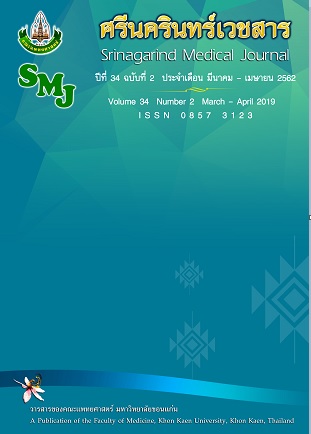Prevalence and Severity of Computer Vision Syndrome of Supporting Staff in Ubon Ratchathani University
Keywords:
prevalence; computer vision syndrome; support staffAbstract
Background and Objective: People who work on a continuous computer screen for a long time can cause a Computer Vision Syndrome (CVS) that may affect their health, such as eye irritation, dry eye, blurred vision or visual overlays. The purpose of this study was to investigate the prevalence and severity of CVS of supporting staffs in Ubon Ratchathani University.
Methods: A cross-sectional descriptive study was in 170 performed supporting staffs. The samples were interviewed by questionnaire and use a lux meter for lighting measurement. Data were analyzed by descriptive statistics and 95% confidence intervals.
Results: The results found that the prevalence of CVS was very high, 99.4% (95%CI: 96.8, 99.9). When classified by CVS group were ocular surface problems, 94.7 (95%CI: 90.1, 97.5), eye strain or tired eye, 95.3% (95%CI: 90.9, 97.9), blurred vision 78.1% (95%CI: 71.1, 84.1), and double vision 42.0% (95%CI: 34.5, 49.8). Most of the CVS were occurred occasionally and miner severity level; however, many cases were eye-sensitivity to light, 14.2% (95%CI: 8.5, 21.7).
Conclusion: Based on this study, the prevalence of CVS of the supporting staffs is very high. Therefore, the eye care activity should be established to reduce the risk factors of these problems.
References
2. Logaraj M, Madhupriya V, Hegde S. Computer Vision Syndrome and Associated Factors Among Medical and Engineering Students in Chennai. Ann Med Health Sci Res [Internet]. [cited Nov 12, 2017] 2014; 4: 179–85. Available from: https://www.ncbi.nlm.nih.gov/pmc/articles/PMC3991936/
3. Sen A, Richardson S. A study of computer-related upper limb discomfort and computer vision syndrome. J Hum Ergol (Tokyo). 2007; 36: 45–50.
4. Blehm C, Vishnu S, Khattak A, Mitra S, Yee RW. Computer Vision Syndrome: A Review. Surv Ophthalmol [Internet]. [cited Oct 11, 2017] 2005; 50: 253–62. Available from: http://www.sciencedirect.com/science/article/pii/S0039625705000093
5. Ranasinghe P, Wathurapatha WS, Perera YS, Lamabadusuriya DA, Kulatunga S, Jayawardana N, et al. Computer vision syndrome among computer office workers in a developing country: an evaluation of prevalence and risk factors. BMC Res Notes 2016; 9: 150.
6. Al Rashidi SH, Alhumaidan H. Computer vision syndrome prevalence, knowledge and associated factors among Saudi Arabia University Students: Is it a serious problem? Int J Health Sci 2017 ; 11: 17–9.
7. ทัศนีย์ ศิริกุล, โกศล คำพิทักษ์. Prevalence of Computer Vision Syndrome in Computer Users. วารสารจักษุธรรมศาสตร์ 2549; 1: 21–8.
8. นรากร พลหาญ, สมสมร เรืองวรบูรณ์, โกมล บุญแก้ว, อนุพงษ์ ศรีวิรัตน์. กลุ่มอาการที่เกิดต่อร่างกายจากการใช้คอมพิวเตอร์ในการปฏิบัติงานของบุคลากรสายสนับสนุน มหาวิทยาลัยนครพนม. วารสารมหาวิทยาลัยศรีนครินทรวิโรฒ สาขาวิทยาศาสตร์และเทคโนโลยี 2557; 6: 26–38.
9. ปาจรา โพธิหัง, พรพรรณ ศรีโสภา, อโนชา ทัศนาธนชัย. ปัจจัยเสี่ยงของกลุ่มอาการจอภาพคอมพิวเตอร์ของบุคลากรสายการสอน ในมหาวิทยาลัยบูรพา. วารสารการพยาบาลและการศึกษา. 2559; 9: 104–19.
10. จามรี สอนบุตร, พิชญา พรรคทองสุข, สุภาภรณ์ เต็งไตรสรณ์. ความชุกและปัจจัยที่มีผลต่อความล้าของตาในผู้ปฏิบัติงานกับเครื่องคอมพิวเตอร์ของคณะแพทยศาสตร์ มหาวิทยาลัยสงขลานครินทร์. สงขลานครินทร์เวชสาร 2552; 27: 91–104.
11. จรูญ ชิดนายี, วิรงค์รอง จารุชาต, ศศิธร ชิดนายี. ความสัมพันธ์ระหว่างความล้าของสายตากับการตรวจสมรรถภาพทางสายตา ในกลุ่มผู้ใช้งานคอมพิวเตอร์ ในโรงพยาบาลอุตรดิตถ์. วารสารวิจัยทางวิทยาศาสตร์สุขภาพ 2556;7: 47–56.
12. Rahman ZA, Sanip S. Computer user: demographic and computer related factors that predispose user to get computer vision syndrome. Int J Bus Humanit Technol. 2011; 1.




